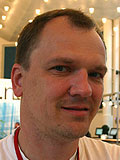Presentation: "Architecture Quality - An Introduction and Overview"
Track:
Architecture Quality
Time:
Wednesday 09:00 - 09:30
Location:
SAS Dania
Abstract: Creating a sustainable software architecture is hard, but nevertheless an inevitable prerequisite for a successful software development. As a consequence, many constructive and retrospective approaches to ensure architecture quality have been created and developed, ranging from techniques like Patterns and Frameworks, over development approaches like Test-Driven Development, to Architecture Reviews and Tools that apply and measure specific quality metrics.
This talk introduces to the different approaches for ensuring architecture quality, discusses their relationships and "interworking", and highlights, which specific approaches are elaborated in more depth by the speakers of the architecture quality track.
 Download slides
Download slides
Tutorial: "Patterns & Practices of Building Sustainable Software Architectures"
Time:
Friday 09:00 - 16:00
Location:
SAS Dania
Abstract: Non-functional properties are key to successful software architectures:
operational qualities, such as stability, performance, and scalability
support the acceptance and usability of a product, developmental qualities,
for instance, flexibility, extensibility, and reusability, help software
development organizations to build and maintain software products within
reasonable cost and time budgets.
It is a challenge, however, to create software architectures that meet
their non-functional requirements -- architectures that are stable, efficient,
scalable, flexible, extensible, reusable, etc.? Many software architectures
actually lack appropriate operational and developmental qualities, and most architecture
reviews focus on evaluating and improving the so-called "ilities" of a software
architecture.
This tutorial, therefore, explores technologies, patterns, and practices
for achieving selected non-functional architectural properties.
For example, what different flavors of scalability exist and what designs
support which type and degree of scalabiliy? How to achieve an appropriate
performance? What designs make a software flexible, and how much flexibility
is actually needed in an application?
For each presented non-functional property the tutorial outlines its design space, the solution technologies available, and the factors and forces that can influence a specific design decision. All aspects are illustrated with anecdotes and war stories from the real-world. Goal is to provide participants with thoughts, considerations, and measures to build usable and sustainable software.
 Frank Buschmann is software engineer at Siemens Corporate Technology in Munich, Germany. His research interests include Object Technology, Application Frameworks and specifically Patterns.
In his development work, Frank has lead the design and implementation of several large-scale industrial software projects, including business information, industrial automation, and telecommunication systems. Frank is co-author of "Pattern-Oriented Software Architecture -- A System of Patterns".
Frank Buschmann is software engineer at Siemens Corporate Technology in Munich, Germany. His research interests include Object Technology, Application Frameworks and specifically Patterns.
In his development work, Frank has lead the design and implementation of several large-scale industrial software projects, including business information, industrial automation, and telecommunication systems. Frank is co-author of "Pattern-Oriented Software Architecture -- A System of Patterns".










